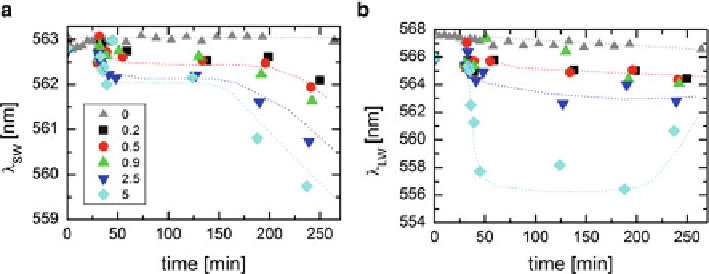Biomedical Engineering Reference
In-Depth Information
Fig. 4.36
PL maximum positions of the SW (
a
)andLW(
b
) components for AM-capped
CdSe/ZnS QDs as a function of observation time and molar ratio
x
=
[
C
PP
]/[
C
QD
](
x
: 0-5).
Lines
are only guide lines. Adapted from [
75
]
b). Like in ensembles experiments this shift is enhanced by even one attached PP
molecule [
75
,
94
] and may be caused by the photooxidation of the QD core material
[
129
].
The overall conclusion with respect to “QD-Dye” nanoassemblies is that there is
a noticeable difference in the photophysical behavior of QD PL upon assembly for-
mation. In addition, our ensemble experiments can be more convincingly interpreted
in a way that predominantly one part of the PL (presumably related to trap states)
is effectively quenched. Since this quenching is enhanced following nanoassembly
formation, we assign the quenched trap states to surface-related states, since they
are expected to react most effectively with attached dye molecules. Single assembly
experiments support this conclusion, but additionally show that also photooxidation
of the CdSe core takes place since the PL is shifting to the blue by up to 20 nm,
which cannot only be explained by modification of surface states. This different
behavior with respect to ensemble experiments might be related to the fact that
during spin coating the surfactant layer is partly (or even completely) lost and
the QD surface can be freely accessed by oxygen, which is often involved in
photodegradation of QDs. The enhancement of the photodegradation process for
QD by attached dye molecule may be tentatively assigned to two reasons. (1) Upon
attachment of dye molecules a large number of ligands are removed, which results
in a more unprotected and thus more reactive surface, which allows for a stronger
photodegradation either of surface states or even of the QD core. (2) Dye-induced
trap states of QDs are more sensitive to photobleaching resulting in apparent spectral
shifts and reduced integrated PL. This latter assumption is supported by experiments
on “QD-Porphyrin” nanoassemblies discussed earlier in this chapter.

